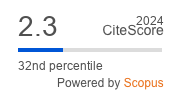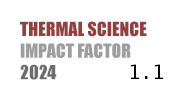THERMAL SCIENCE
International Scientific Journal
Thermal Science - Online First
online first only
The hydraulic role of elbows in rectangular ducts of HVAC distribution systems analysed by CFD
ABSTRACT
Ducts with rectangular cross-section are widely used in HVAC (heating, ventilation and air conditioning) distribution systems applied to residential, commercial and industrial buildings where round elements can't be used. Usual practical problem is calculating the required pressure drop to drive the air flow for a given duct geometry at a certain flow rate, for which the total hydraulic losses should be obtained. Friction losses in ducts depend on their size, flow capacity and construction material, while minor losses are caused by changes in flow stream direction, expansions or contractions, fittings and valves. The installation of elbow in a channel can induce larger losses due to local flow separation and swirling secondary flow. Viscous incompressible flow of air in the ducts was modelled and simulated. Hydraulic losses in cascade connected straight rectangular sections by three elbows are evaluated with the application of Computational Fluid Dynamics (CFD). Rectangular ducts which have the same hydraulic diameter but differ according to the lengths of their straight sections were being analysed. The numerically obtained loss coefficients were compared with available theoretical data and show good agreement especially in a selected range of Reynolds number. A conclusion is drawn from the comparative analysis that the lengths of the straight sections between the elbows significantly influence the duct hydraulic resistance because of the contribution to the velocity profile uniformity. Moreover, during the separate analysis of the elbows, it is detected that the elbow position in the system is an influencing parameter on the elbow loss coefficient.
KEYWORDS
PAPER SUBMITTED: 2024-12-30
PAPER REVISED: 2025-03-03
PAPER ACCEPTED: 2025-03-11
PUBLISHED ONLINE: 2025-04-05
- Smyk, E., Markowicz, M., Szyca, M., Selection of the cross-section area shape of the ducts used in the shelter ventilationsystems - analysis, Engineering Expert, No. 1, 2022, pp. 9-17, DOI: 10.37105/enex.2022.1.02
- Zmrhal, V., Schwarzer, J., Numerical simulation of local loss coefficients of ventilation duct fittings, Proceedings, 11th International IBPSA Conference, Glasgow, Scotland, 2009, pp. 1761- 1766
- Idelchik, I. E., Handbook of hydraulic resistance (A. S. Ginevskiy, A. V. Kolesnikov, Eds.; 4th ed. translated by Greta R. Malyavska), Begell House, 2007
- Recknagel, H., Sprenger, E., Schramek, E., Taschenbuch fur Heizung + Klimatechnik 05/06, Oldenbourg Wissenschaftsverlag, Germany, 2004
- Liu, W., Long, Z., Chen, Q., A procedure for predicting pressure loss coefficients of duct fittings using computational fluid dynamics (RP-1493). HVAC&R Research, 18 (2012), 6, pp. 1168- 1181, doi.org/10.1080/10789669.2012.713833
- dos Santos, A. P. P., Andrade, C. R., Zaparoli, E. L., CFD prediction of the round elbow fitting loss coefficient, International Journal of Mechanical and Mechatronics Engineering, 8 (2014), 4, pp. 743-747
- Smyk, E., Stopel E., Szyca M., Simulation of Flow and Pressure Loss in the Example of the Elbow, Water, 16 Issue13 (2024), 1875; doi.org/10.3390/w16131875
- Röhrig, R., Jakirlić, S., Tropea, C., Comparative computational study of turbulent flow in a 90° pipe elbow, International Journal of Heat and Fluid Flow, 55 (2015), pp. 120-131, doi.org/10.1016/j.ijheatfluidflow.2015.07.011
- Jurga, A. P., Janocha, M. J., Yin G., Ong , M C., Numerical Simulations of Turbulent Flow Through a 90-Deg Pipe Bend, J. Offshore Mech. Arct. Eng., 144 (2022), 6, doi.org/10.1115/1.4054960
- Dutta, P., Nandi, N., Numerical analysis on the development of vortex structure in 90° pipe bend, Progress in Computational Fluid Dynamics, An International Journal (PCFD),. 21 (2021), 5, www.inderscience.com/offers.php?id=117466
- Dutta, P., Chattopadhyay, H., Nandi, N., Numerical Studies on Turbulent Flow Field in a 90 deg Pipe Bend, J. Fluids Eng., 144 (2022), 6: 061104, doi.org/10.1115/1.4053547,
- Caoa, X., Zhanga, P., Li, X., Li, Z., Zhanga, Q., Bian, J., Experimental and numerical study on the flow characteristics of slug flow in a horizontal elbow, Journal of Pipeline Science and Engineering (2022), 2, www.sciencedirect.com/science/article/pii/S2667143322000488?via%3Dihub
- Zahedi, R., Rad, A. B., Numerical and experimental simulation of gas-liquid two-phase flow in 90-degree elbow, Alexandria Engineering Journal 61 (2022), 3, pp. 2536-2550
- Weissenbrunner, A., Ekat, A., Straka, M., Schmelter, S., A virtual flow meter downstream of various elbow configurations, Metrologia 60 (2023) 054002 (15pp), doi.org/10.1088/1681-7575/ace7d6
- Cuming, H. G., The Secondary Flow in Curved Pipes, Aeronautical Research Council Reports and Memoranda No. 2880, London, 1952
- Stanković, B. D., Belošević, S. V., Crnomarković, N. D., Stojanović, A. D., Tomanović, I. D., Milićević, A. R., Specific aspects of turbulent flow in rectangular ducts, Thermal Science 21 (2017), 3, pp. 663-678, doi.org/10.2298/TSCI160201189S
- Stojkovski, V., Lazarevikj, M., Iliev, V., Dillema about influence of splitter vanes on hydraulic characteristic at rectangular radius elbow, 6th International Scientific Conference on Mechanical Engineering Technologies and Applicatios COMETa, Jahorina, Bosnia and Herzegovina, 2022, pp. 602 - 614

